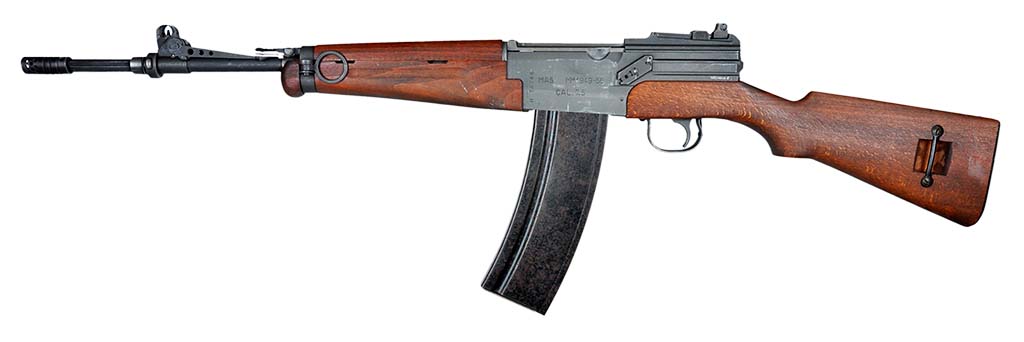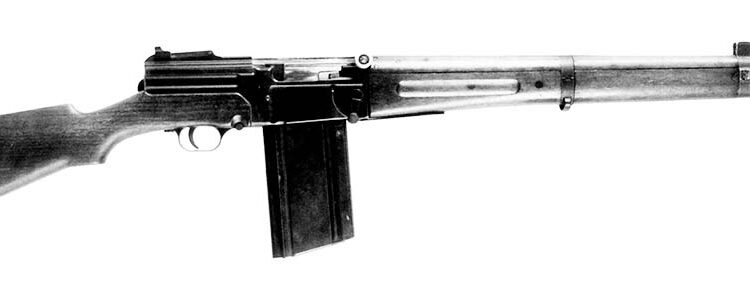By Jean Huon –
A semiautomatic rifle was registered in a 1946 program, but research completed before the War was advanced enough to avoid any new development.
MAS 40
The French Army looked for a semiautomatic rifle at the end of 19th century. Many prototypes were developed, and one of them, the Meunier A6, was ready to be adopted in 1913, but the times were very uncertain, and it would have been risky to change the French Army’s rifle.
Later, an M1917 rifle was used during WWI but appeared not serviceable due to the design of its cartridge case: the 8x51mm Rimmed Lebel.
In 1921, an ambitious program was launched to replace all the existing French military small arms. Several models developed both by state arsenal and private factories were tested—the choice was a semiautomatic rifle developed by Saint-Etienne in 1938. Adopted on March 28, 1940, its production was planned for 1941; unfortunately, history decided otherwise.
MAS 44
The Saint-Etienne area was liberated end of August 1944. The MAS (Manufacture d’Armes de Saint-Etienne) factory improved the MAS 40 model which received a box magazine. The rifle was adopted on January 11, 1945, but it was not completely finished.
The magazine’s elastic release catches were replaced by a solid lock installed on the right side of the box. Production was 6,200 rifles, mainly used by the Navy commandos in French Indochina.

MAS 49
The MAS 49 is an improved version of the MAS 40, with a new rear sight; no bayonet; a scope mount; and a grenade launcher, the same as the MAS 36 LG48’s.
Description of the First MAS 49 Model
The MAS 49 has a wooden stock, very similar to the one of the MAS 36’s, a long forearm with a handguard, swivel band and forward band. The frame has flat sides, a cover and receives a tilting two-part bolt, locked on a hard steel wedge. It is loaded from a vertical box magazine. After the last round, the bolt is retained in the rear position by a bolt stop.
The bore has four left turning grooves, with one spin in 270mm (10.62 inches). The gas cylinder has no piston.
The sights are a tangent rear sight scaled from 200m to 1,200m (1,300 yards) and a front sight protected by ears.Only 20,600 rifles were made and put into service in the Army and the Navy. The first use of the MAS 49 was by snipers with the excellent APX L806 scope.
Features MAS 49
Ammunition 7.5x54mm
Overall length 1.075m (42.32in)
Barrel length 0.580m (22.83in)
Weight 3.900kg (8.60lb)
Magazine capacity 10 rounds
Description of a Second Version
After discarding the 50mm M1948 rifle grenade (an adaptation of the M1937 mortar shell), the MAS 49 rifles were modified—the grenade sights and grenade ring were removed. It was fitted with a new forearm and handguard. Some MAS 49 models remained in service until 1995.
.30-06 Variation
At the beginning of the 1950s, the Western Europeans and the North American armies were willing to have a standardized armament. The American .30-06 cartridge was selected as a common rifle cartridge. Several prototypes were developed for it, particularly:
- The MAS 49 rifle with standard stock. It had a lengthened frame to accommodate the American cartridge;
- A folding stock variation, similar to the MAS 36 CR39, without a grenade launcher.
Export Variation
Syria adopted the MAS 49, and 6,000 rifles were made, similar to the French model, with a grenade launcher. They also received the bayonet of the MAS 36. Some of them were sold by Century Arms in the 1990s.
The Hunting MAS 49
The MAS tried to create a sporterized model of the MAS 349 for hunting. It used the “long frame” of the .30-06 model: 260mm in length (10.23 inches) instead of 230mm (9.05 inches). The reason for this choice was to allow the use of various hunting cartridges. Only one prototype was made; it received a blued finished frame and a walnut stock. It was chambered for the 7×57 cartridge.

The MAS 49-56
At the beginning of the 1950s, the European Defense Community was rejected by France, and NATO favored the adoption of the 7.62mm NATO cartridge for which several prototypes of assault rifles were made in France. Improvements of the MAS 49 were attempted.
The several prototypes (MAS 49-53, 49-54) received a 22mm grenade launcher similar to the one installed on the MAS 35 M51 repeating rifle. The next one was the MAS 49-55 designed by Paul Tellié (FAMAS’s father). It has a shortened forearm and a gas cylinder and a hand-operated valve to allow grenade launching. A muzzle brake was fitted on the barrel mouth to reduce the recoil and the blast of the shot. After some more improvements, it became the MAS 49-56 model and was adopted on May 24, 1956.
Manufacturing tests were completed, and the rifle No. 1 was completed on January 1958. It entered into service gradually, and by the mid-1960s the French Army was completely outfitted with this 7.5mm rifle. The rifle can be fitted with a scope and an M1956 knife bayonet with a 220mm (8.7-inch) blade. The cross and back guards have 22mm rings. The cocking lever has a black plastic pad. The bayonet scabbard is made of phosphate sheet metal with brown or khaki belt loop.
Production ceased in 1978—275,240 MAS 49-56 models were made.
Features MAS 49-56
Ammunition 7.5x54mm
Overall length 1.020m (40.15in)
Barrel length 0.525m (22.67in)
Weight 3.900kg (8.60lb)
Magazine capacity 10 rounds
MAS 49-56 with Folding Stock
Developed for the airborne troops, the MAS 49-56 with folding stock was developed as the MAS 49-56 CR 59 and later as the MAS 4-56 CR 60. The rear part of the frame is fitted with a light alloy block. The rifle has a pistol grip and a folding stock which is retained by a transversal screw and a wing nut. The stock is made of a tube with a rubber coating and a thick rubber pad.
This rifle can exceptionally launch grenades but has no grenade sights, ring or gas cylinder hand-operated valve. It can receive the M1956 bayonet.
Officially adopted on July 20, 1960, it was never manufactured! It could have been made in 7.5x54mm or 7.62mm NATO calibers. The scarce specimens we can observe were all made in 7.62mm NATO.

Features MAS 49-56 CR 60
Ammunition 7.5x54mm or 7.62x51mm
Overall length 1.040m (40.95in)
Length with stock folded 0.750m (29.52in)
Barrel length 0.525m (22.67in)
Weight 3.300kg (8.60lb)
Magazine capacity 10 rounds

The MAS 49-56 M.S.E.
During these early years, NATO members organized a shooting competition annually in Germany, and in 1967, a French shooter using the FR F1 sniper rifle won the competition. The American team claimed that the FR F1 was not a military rifle but a sporting one! To avoid such a claim, the French Headquarters asked the MAS to develop a variation of the MAS 49-56, which was called the “MAS 49-56 M.S.E.” (Manufacture d’Armes de Saint-Etienne). It was developed in 1968 from new or rebuilt rifles. The intended production amounted to 3,000 rifles, but only 900 were made: 100 for the Army, 260 for the Air Force, 220 for the Gendarmerie and 300 for export.
Improved kits were made by the MAS and assembled by the MAS, MAT (Manufacture d’Armes de Tulle) or Poitiers ordnance workshops. They included: an ergonomic stock with plastic cheek pad; a pistol grip; improved sights; an adjustable trigger mechanism; and a large-capacity magazine obtained from an M1924 M29 LMG.
Blank, grenade-launching or short-range cartridges cannot be used. If necessary, each rifle could be retrofitted to the service version.

The 7.62mm NATO MAS 49-56
After the May 1968 riots in Paris, the Home Office decided to replace the old Berthier M1916 carbines with new rifles. The Defense Ministry could not furnish the MAS 36 model, which was reserved for the second-line troops in case of war with the Soviet Union. The Armament Office Center of the Police was then tasked to select a new rifle.
In 1977, 18 rifles and carbines were tested, including several hunting carbines, a 7.62mm NATO MAS 49-56 with a light alloy firing pin to avoid inertia shooting and a laminated wood stock. The grenade launcher was improved for tear-gas grenade launching.
Few rifles were made, the highest serial number observed was No. 205. Numbering seems to have begun at 100, and no more than 150 rifles could have been made. But finally, the French police selected a variation of the Ruger Mini-14 in 5.56mm to be designed and assembled in France.
AME Semiautomatic Rifle The Mulhouse arsenal developed a semiautomatic rifle in the 1950s. It looks like the German G43 and uses a bolt locked by lateral rolls with delayed blowback action. The designer was the German engineer Loffler
| This article first appeared in Small Arms Review V25N1 (January 2021) |












